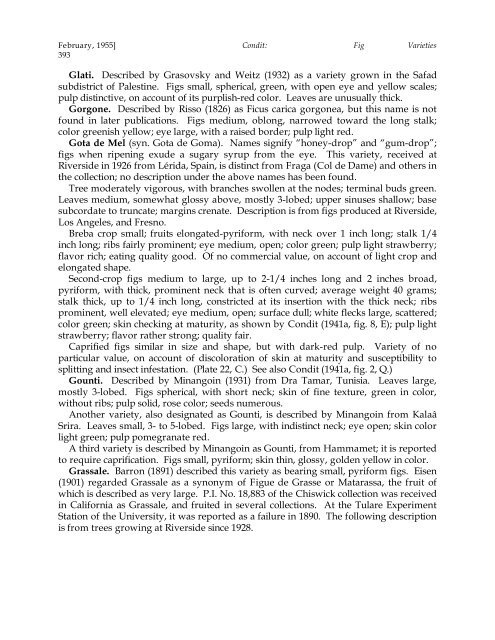Fig Varieties: A Monograph - uri=ucce.ucdavis
Fig Varieties: A Monograph - uri=ucce.ucdavis
Fig Varieties: A Monograph - uri=ucce.ucdavis
Create successful ePaper yourself
Turn your PDF publications into a flip-book with our unique Google optimized e-Paper software.
February, 1955] Condit: <strong>Fig</strong> <strong>Varieties</strong><br />
393<br />
Glati. Described by Grasovsky and Weitz (1932) as a variety grown in the Safad<br />
subdistrict of Palestine. <strong>Fig</strong>s small, spherical, green, with open eye and yellow scales;<br />
pulp distinctive, on account of its purplish-red color. Leaves are unusually thick.<br />
Gorgone. Described by Risso (1826) as Ficus carica gorgonea, but this name is not<br />
found in later publications. <strong>Fig</strong>s medium, oblong, narrowed toward the long stalk;<br />
color greenish yellow; eye large, with a raised border; pulp light red.<br />
Gota de Mel (syn. Gota de Goma). Names signify “honey-drop” and “gum-drop”;<br />
figs when ripening exude a sugary syrup from the eye. This variety, received at<br />
Riverside in 1926 from Lérida, Spain, is distinct from Fraga (Col de Dame) and others in<br />
the collection; no description under the above names has been found.<br />
Tree moderately vigorous, with branches swollen at the nodes; terminal buds green.<br />
Leaves medium, somewhat glossy above, mostly 3-lobed; upper sinuses shallow; base<br />
subcordate to truncate; margins crenate. Description is from figs produced at Riverside,<br />
Los Angeles, and Fresno.<br />
Breba crop small; fruits elongated-pyriform, with neck over 1 inch long; stalk 1/4<br />
inch long; ribs fairly prominent; eye medium, open; color green; pulp light strawberry;<br />
flavor rich; eating quality good. Of no commercial value, on account of light crop and<br />
elongated shape.<br />
Second-crop figs medium to large, up to 2-1/4 inches long and 2 inches broad,<br />
pyriform, with thick, prominent neck that is often curved; average weight 40 grams;<br />
stalk thick, up to 1/4 inch long, constricted at its insertion with the thick neck; ribs<br />
prominent, well elevated; eye medium, open; surface dull; white flecks large, scattered;<br />
color green; skin checking at maturity, as shown by Condit (1941a, fig. 8, E); pulp light<br />
strawberry; flavor rather strong; quality fair.<br />
Caprified figs similar in size and shape, but with dark-red pulp. Variety of no<br />
particular value, on account of discoloration of skin at maturity and susceptibility to<br />
splitting and insect infestation. (Plate 22, C.) See also Condit (1941a, fig. 2, Q.)<br />
Gounti. Described by Minangoin (1931) from Dra Tamar, Tunisia. Leaves large,<br />
mostly 3-lobed. <strong>Fig</strong>s spherical, with short neck; skin of fine texture, green in color,<br />
without ribs; pulp solid, rose color; seeds numerous.<br />
Another variety, also designated as Gounti, is described by Minangoin from Kalaâ<br />
Srira. Leaves small, 3- to 5-lobed. <strong>Fig</strong>s large, with indistinct neck; eye open; skin color<br />
light green; pulp pomegranate red.<br />
A third variety is described by Minangoin as Gounti, from Hammamet; it is reported<br />
to require caprification. <strong>Fig</strong>s small, pyriform; skin thin, glossy, golden yellow in color.<br />
Grassale. Barron (1891) described this variety as bearing small, pyriform figs. Eisen<br />
(1901) regarded Grassale as a synonym of <strong>Fig</strong>ue de Grasse or Matarassa, the fruit of<br />
which is described as very large. P.I. No. 18,883 of the Chiswick collection was received<br />
in California as Grassale, and fruited in several collections. At the Tulare Experiment<br />
Station of the University, it was reported as a failure in 1890. The following description<br />
is from trees growing at Riverside since 1928.
















![Fig Trees in North Carolina [Archive] - IDigMyGarden ... - Figs 4 Fun](https://img.yumpu.com/26905320/1/190x245/fig-trees-in-north-carolina-archive-idigmygarden-figs-4-fun.jpg?quality=85)